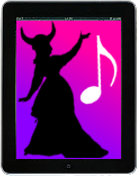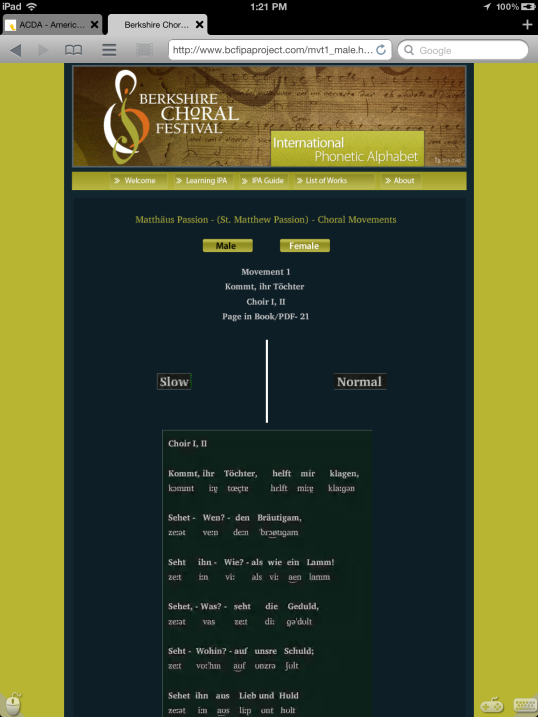
Credit: Encyclopædia Britannica, Inc.
Now that my music performance commitments for the holidays and the fall are behind me, I’m coming up for air and for a report on how things went from a technology perspective:
1. Regular choir rehearsals & concerts
The process used by our de facto e-music librarian for scanning and distributing PDF scores has really become quite smooth and streamlined (thanks, Steve!!). You can read about his scanning workflow in his guest post on my blog. He makes the scores available for download on a private website in two formats: as a forScore .4sc file for iPad users in the choir (since we are all using forScore) and as a PDF file for non-iPad tablet users. In the forScore version of the file, Steve packages the scores into a forScore setlist and adds metadata (mainly title and composer) and links (for handling repeats, D.S./D.C. etc.) before he sends them out. This is a huge boon to us tablet users – our music is already organized when we import it into forScore, and when sight-reading, it only takes us one tap to navigate to the right spot in the score while everyone else is madly flipping paper pages and hunting for the repeat sign or the second ending (I especially love this perk). I did learn, however, that I personally prefer to keep the printed page numbers in the PDF score rather than cropping them out with the margins to make the music notation display bigger and more readable. (Ask me in 20 years if I feel the same.)
I was astonished to learn that 20% of our choir has adopted tablets for reading and performing music. It helps that we are in Silicon Valley, and it also helps that Steve has been a low-key evangelist of sorts and has made the onboarding process very easy. I like to think that my forScore tutorial series, which I have shared with fellow choristers, has also helped.
Our conductor owns an iPad, but so far he has not conducted from it yet. I don’t blame him – when you need a musical “roadmap”, it’s not so great when you can only see one shrunken page at a time, and it’s even worse if you need to read anything more complicated than a simple vocal score with piano. A larger-format iPad would help, or even (if you can afford it) two iPads showing two adjacent pages of the score, but with synchronized page turns (the unrealBook music reader app supports this scenario – wow!).
The iRecorder app for iPad came in handy during one choir rehearsal when we had to learn a traditional African song by ear. I used my iPad to record a live performance of the song by our guest artists who came to rehearse with us, and then I uploaded and shared the recording with fellow choir members for later review.
2. Working on art songs & arias in voice lessons and coachings
One of my big projects this fall was to get Claude Debussy’s song cycle, Ariettes oubliées, under my belt in its entirety (it’s still in rough form, as my coach will attest). I bring my iPad with my music on it to lessons and coachings (and a normal binder with paper copies for my pianist, of course). Despite my complaints in a previous post, I’m facile enough with annotating music on my iPad that I can keep up with the notes I’m being given during a coaching or lesson. Sometimes I’ll go back through the score later and make things more legible by replacing my messy stylus scrawl with forScore stamp markings.
I prepared my own translations and diction notes, getting the source text from The Lied, Art Song, and Choral Texts Archive, looking up word translations and IPA on the French-English dictionary at WordReference.com (they have many other languages too), and referencing information from one of my diction textbooks that I scanned and transferred to my iPad. I put this information into a Word document which I then added to my Dropbox folder. From there, I can access it anytime from either my iPad or my Android phone for study. I usually also convert the document into a PDF so I can import it into my forScore library together with the actual score. What I’d really like to do is to be able to edit the Word document on my iPad with automatic Dropbox sync so I can work on translations, etc. on the go, but my current Office suite editor app, Quickoffice, isn’t up to the task yet. When I edit my .docx Word file in Quickoffice and sync it to Dropbox, the document sometimes gets temporarily corrupted and become unreadable in Quickoffice. Fortunately, opening and saving the document on my laptop fixes it. I really really hope Quickoffice fixes this issue, but for now I only edit my document on my laptop and use my iPad and phone just for reading it without editing. Finally, I write my translation into the score using forScore’s text annotation feature:

I went to the university music library and used my iPad camera, makeshift scanning stand, and Scanner Pro app to scan the chapter on Ariettes oubliées from Pierre Bernac’s book, The Interpretation of French Song. (Side note: When using my iPad scanning setup, it’s a lot faster and easier to scan multiple pages from a smaller book like this, versus the big, bulky Castel libretto books.) It was really handy to have the book pages with me on my iPad at coachings. I checked to see if the Bernac is available as an e-book, but no dice – if I want to have the whole enchilada on my iPad, I’ll need to buy a physical book and then scan it myself. The Bernac also suggests metronome markings for the various songs, and Chris R. from Technology in Music Education reminded me that forScore’s virtual metronome will remember settings for individual songs or forScore bookmarks, so I’ll have to try plugging Bernac’s suggested tempi into forScore as a way to remind myself of the approximate tempo.
I also bought and listened to multiple recordings of songs from Ariettes oubliées on iTunes on my iPad. I used forScore’s feature for assigning song tracks to scores, which lets me listen to the track while reading the score. I wish forScore had a way of assigning multiple songs or a playlist to the same score. That would make it easier for me to do comparative listening of different artists performing the same song. Also, I purchased piano accompaniment tracks for Ariettes oubliées from Your Accompanist and mp3accompanist.com for practicing when there’s no pianist available. As for basic learning & note-bashing of the vocal line–my iPad, forScore’s virtual piano, and a pair of headphones let me do that anywhere, and it’s been useful for turning my occasional train commute into productive music-learning time.
I’ve also been using forScore setlists as virtual binders for lessons and coachings – I can quickly swap pieces of music in and out depending on what I want to work on during a particular session. (I set up “virtual binders” for a lot of other things too – audition rep, concert/recital programs, new musical projects that I’m working on, etc.)
And speaking of teaching studios, those of you who have one might like to check out the online service, Music Teacher’s Helper (description on their website: “Designed by music teachers, for music teachers, to help you manage the business aspects of running a private music teaching studio”). I recently scheduled a lesson with a teacher who uses it, and it sent me a helpful little automated reminder email before my lesson. It also does other useful administrative tasks, and I’ve heard other teachers recommend it.
(I have more to share, but it’s time to call it a night…to be continued in part 2…)

















